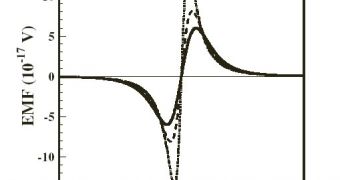Measuring the mass of macroscopic objects is relatively easy, however when we're talking about elementary particles with masses lower than E-30 kilograms (one followed by 30 zeros!), the mass of the electron, things tend to get rather complicated. Usually, the mass of particles is calculated through mathematical methods, by deriving it from the properties of the respective particles observed in real life experiments. On the other hand, neutrinos are not electrons, and their properties allow part of them to travel through the whole mass of our planet without interacting with regular matter.
I said regular matter because due to its low interactions, neutrino is also the first particle to be considered a form of dark matter; physicists in general believe that the mass of the neutrino may hold the answer to the final outcome of the universe, and may weigh about a million times less than an electron. Nonetheless, one thing is for certain. It does have a mass! SuperKamiokande researchers from Japan revealed, in an experiment back in 1998, that the ratio between the electron-type to muon-type neutrinos produced by cosmic rays on one side of the Earth was different than that measured on the other side, meaning that indeed the neutrino must have a mass, regardless of how small it is.
Previous to this experiment, the Standard Model of particles physics postulated that neutrinos had no mass. But if neutrinos do have mass, then they must exhibit magnetic moments which could be measured in order to approximate its mass, says Michael Schmitt of Northwestern University. Schmitt is the lead author of a study proposing a new way of calculating the mass of neutrinos.
He argues that neutrinos' oscillations may provide a starting point from which their mass can be calculated, as the probability that a type of neutrino would oscillate into another is proportional to the square mass differences between the two particles.
Aram Apyan, undergraduate student at the Illinois Institute of Technology, son of Armen Apyan, and participant in the study, has been able to calculate the shape of the electrical pulse induced by a neutrino as it masses through a loop wire. As the magnetic momentum which generates the electrical current is proportional to the mass of the neutrino, then physicists could accurately calculate its mass.
And here comes the problem. Only by suggesting that the neutrino elementary particles have a mass higher than 1 electronVolt, or E-36 kilograms, would result that it may exhibit a magnetic momentum E-10 'Bohr magnetons', which will generate, through a loop wire, an electrical current with a voltage of 16 orders of magnitudes smaller that 1 Volt. To make things even worse, the pulse only lasts about E-21 seconds.
Such an experiment could be conducted with the help of a superconducting quantum interference device or SQUIDS, but according to Sunil Somalwar from the Rutgers University, using a rather similar device in 1980, during a study of magnetic monopoles, SQUIDS have sensitivities of only E-15 Ampere, too low to measure a current of E-45 Ampere. Even by using bunches of neutrinos in particle accelerators, such signal, would not be detected.
Though conscious that such signals are too weak to be measured through any available current experiment, Schmitt says that an alternative solution may be found in the behavior of the magnetic moment of particles under Lorentz transformations.

 14 DAY TRIAL //
14 DAY TRIAL //